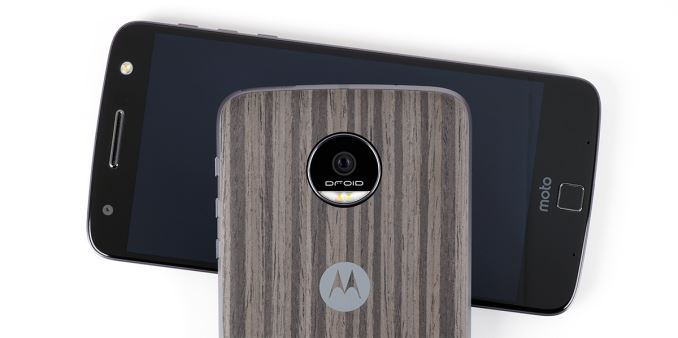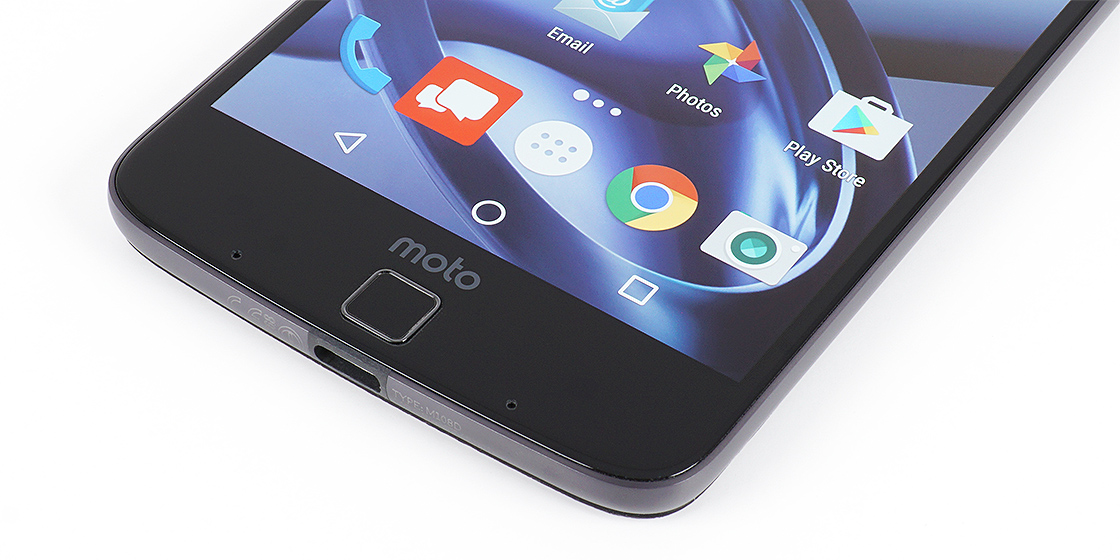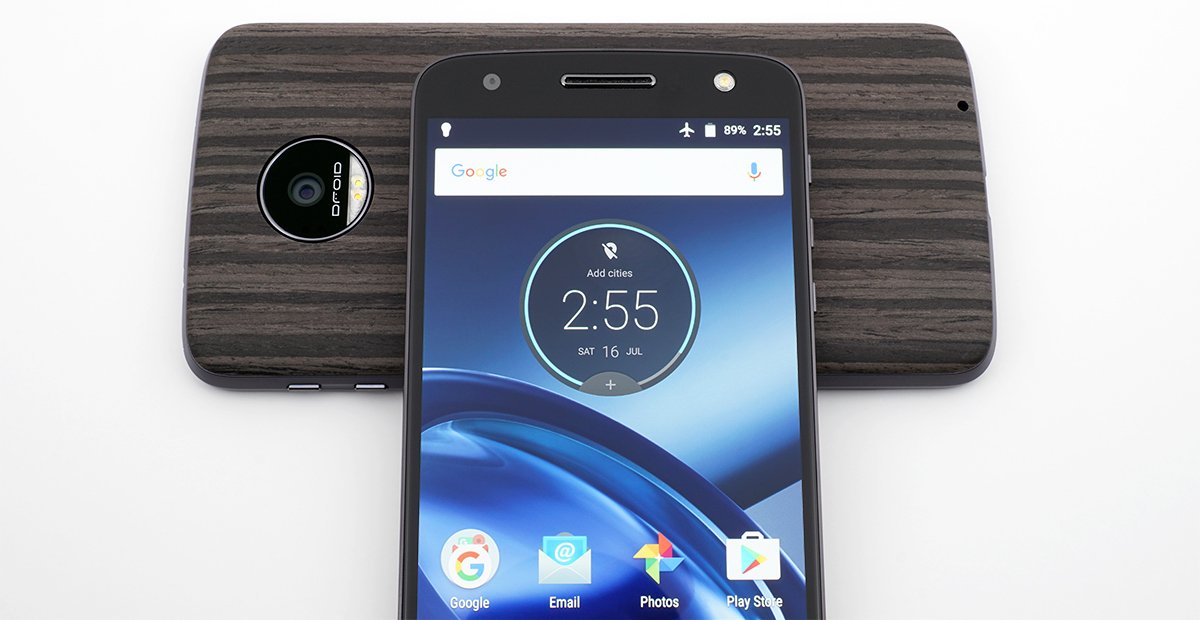Review Motorola Moto Z Force Edition 2nd Gen

The relationship between Motorola and Verizon dates back to 2009 and the original Motorola Droid smartphone. Since then, the 2 companies have paired up for a number of Droid branded phones that are either only available from Verizon initially or are slightly tweaked models sold but by Verizon. When Motorola appear that the Moto Z and Moto Z Force will exist replacing the Moto X family as the company's flagship devices at Lenovo's Tech Earth event in June, information technology came as no surprise and so that both phones would continue the Droid legacy and land exclusively on Verizon'due south network first.
Unlocked versions of the Moto Z and Moto Z Strength will be bachelor directly from Motorola before the end of the twelvemonth, merely instead of waiting for the general release, we decided to go hands-on with Verizon's Droid Editions, which use identical hardware.
| Motorola Moto Z Droid Family unit | ||
| Moto Z Droid | Moto Z Forcefulness Droid | |
| SoC | Qualcomm Snapdragon 820 (MSM8996) 2x Kryo @ ii.15GHz | Qualcomm Snapdragon 820 (MSM8996) 2x Kryo @ two.15GHz |
| RAM | 4GB LPDDR4-3188 | 4GB LPDDR4-3188 |
| NAND | 32GB / 64GB (UFS 2.0) + microSD | 32GB / 64GB (UFS 2.0) + microSD |
| Display | 5.5-inch 2560x1440 SAMOLED Corning Gorilla Glass | 5.5-inch 2560x1440 SAMOLED Moto ShatterShield |
| Dimensions | 153.3 x 75.three x 5.19 mm 136 grams | 155.ix x 75.viii x half dozen.99 mm 163 grams |
| Modem | Qualcomm X12 (Integrated) 2G / 3G / 4G LTE (Category 12/13) | Qualcomm X12 (Integrated) 2G / 3G / 4G LTE (Category 12/thirteen) |
| SIM Size | NanoSIM | NanoSIM |
| Forepart Photographic camera | 5MP, one/4" OmniVision OV5693, i.4µm pixels, f/2.ii, Auto HDR, LED flash | 5MP, ane/4" OmniVision OV5693, i.4µm pixels, f/2.two, Auto HDR, LED flash |
| Rear Photographic camera | 13MP, 1/iii.06" Sony IMX214 Exmor RS, 1.12µm pixels, f/1.viii, Laser AF, OIS, Auto HDR, dual-color LED flash | 21MP, i/2.iv" Sony IMX338 Exmor RS, 1.12µm pixels, f/1.8, PDAF + Light amplification by stimulated emission of radiation AF, OIS, Auto HDR, dual-color LED flash |
| Battery | 2600 mAh non-removable | 3500 mAh non-removable |
| Connectivity | 802.11a/b/g/n/ac 2x2 MIMO, BT iv.1 LE, NFC, GPS/GNSS, USB Blazon-C, Moto Mods connector | 802.11a/b/g/due north/ac 2x2 MIMO, BT 4.1 LE, NFC, GPS/GNSS, USB Type-C, Moto Mods connector |
| Launch OS | Android 6.0.one | Android 6.0.one |
| Launch Toll (No Contract) | $624 ($26/mo) / $674 | $720 ($30/mo) / $770 |
Just similar we've seen with most other flagship phones from this generation, the two Moto Z Droids come with Qualcomm's Snapdragon 820 SoC and 4GB of LPDDR4 RAM. Both models have either 32GB or 64GB of UFS two.0 NAND, although the 64GB selection is simply available online through Motorola's Moto Maker website. Internal storage tin can as well be expanded with microSD cards. The Moto Z Droids have wireless connectivity covered with Qualcomm'due south latest X12 baseband processor integrated into the SoC, Bluetooth iv.1 LE, NFC, and 802.11ac 2x2 MIMO Wi-Fi.
Unlike the Moto Ten phones, the Moto Z Droids come up with a touch-based fingerprint sensor, a convenient security feature for unlocking the phone, authorizing purchases, and making mobile payments with Android Pay. And so far I've found the new fingerprint sensor to be very reliable, unlocking the phone extremely quickly regardless of finger position. As with other capacitive sensors, it still has trouble with moisture and large changes in temperature, but its sensitivity to environmental factors is no worse than other solutions.
Neither of the Moto Z Droids support wireless charging, but they practice include Motorola's TurboPower fast-charging technology, which uses the included 15W or 30W chargers to provide up to 8 or xv hours of bombardment life in just xv minutes for the Moto Z Droid and Moto Z Force Droid, respectively, according to Motorola. Some other shared feature is a water-repellant nano coating that protects the phones from accidental spills or lite pelting, but does not provide actual water or dust proofing like Samsung'southward IP68 rated Galaxy S7.

While much of the internal hardware is the same, there are a few notable differences between the 2 models, the most significant being bombardment size. The Moto Z Droid comes with a 2600mAh battery, which is below the roughly 3000mAh average for phones with 5.five-inch displays. The Moto Z Force Droid bumps battery chapters to 3500mAh, which brings it shut to the 3600mAh battery in Samsung'southward Galaxy S7 edge. Differences in software and brandish efficiency will likely decide if the Strength Droid can outlive the Galaxy S7 edge.
Both Moto Z Droids have the same 5MP front-facing camera with wide-angle lens that uses a defended LED flash and automated HDR imaging to aid capture selfies over a wider range of lighting conditions. The rear cameras both take large f/one.8 apertures and optical prototype stabilization to improve low-light epitome quality, only they use dissimilar sensors and autofocus systems. The Moto Z Droid includes a 13MP Sony sensor that pairs standard dissimilarity-based autofocus with a laser to amend focus operation in low calorie-free. The Moto Z Forcefulness Droid uses a more advanced 21MP Sony sensor with deep trench isolation (DTI) technology for improved colour fidelity. It also uses a hybrid autofocus system that combines laser, phase detection (PDAF), and dissimilarity detection methods, which should provide faster, more than reliable focusing performance in a variety of lighting conditions.

While the Moto Z Droid'south screen is covered edge to border with Corning Gorilla Drinking glass, the Moto Z Forcefulness Droid uses Motorola'due south second-generation Moto ShatterShield technology, a five-layer organization that starts with an aluminum panel as a base to go on the 5.5-inch AMOLED screen from flexing. Two carve up touch layers above the display provide redundancy in case one of the layers is damaged. A clear, flexible lens, likely fabricated from a polycarbonate, is next. A 2d protective lens with a proprietary hardcoat completes the display stack. This assembly improves the screen'southward resistance to cracking or shattering if dropped, which Motorola backs by a four-year warranty.
The new Moto Z Droids' specifications and hardware are impressive but not that much different than what'due south currently available with other flagships. To make its new phones more enticing, Motorola made them modular. The thought of easily swappable accessories that extend a phone's functionality shows hope but has not fully materialized—at least not all the same. Will Motorola'due south Moto Z and its modular accessories, called Moto Mods, prove useful or will they merely be some other wacky thought that goes nowhere?
Design


Source: https://www.anandtech.com/show/10493/motorola-moto-z-force-droid-review
0 Response to "Review Motorola Moto Z Force Edition 2nd Gen"
Post a Comment